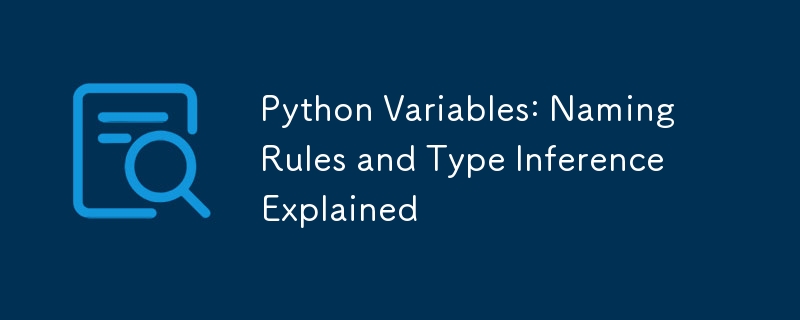 Backend Development
Backend Development
 Python Tutorial
Python Tutorial
 Python Variables: Naming Rules and Type Inference Explained
Python Variables: Naming Rules and Type Inference Explained
Python Variables: Naming Rules and Type Inference Explained

Python is a widely used programming language known for its simplicity and readability. Understanding how variables work is fundamental for writing efficient Python code. In this article, we’ll cover Python variable naming rules and type inference, ensuring that you can write clean, error-free code.
Python Variable Naming Rules
When naming variables in Python, certain rules must be followed to ensure your code runs smoothly:
Case-Sensitive: Python distinguishes between uppercase and lowercase letters. For example, age and Age are treated as two different variables.
-
Starts with a Letter or Underscore: A variable name must begin with a letter (a-z, A-Z) or an underscore (_). It cannot start with a number.
- Correct: _my_var, name1
- Incorrect: 1name, -age
-
Alphanumeric and Underscores: After the first character, the variable name can include letters, numbers, and underscores.
- Correct: my_var2, first_name
- Incorrect: my-var, first name
-
No Spaces Allowed: Spaces are not allowed in variable names. Use underscores to separate words.
- Correct: total_amount
- Incorrect: total amount
Avoid Reserved Keywords: Python has reserved keywords like class, def, if, etc., which cannot be used as variable names.
-
Naming Conventions: Although Python doesn't enforce naming styles, it’s a good practice to follow conventions:
- Use lowercase for regular variables (total_sum).
- Use uppercase for constants (PI, MAX_SIZE).
- Use descriptive names that reflect the purpose of the variable (user_count, not x).
Python Type Inference
Python is a dynamically typed language, which means that variable types are determined automatically at runtime based on the value you assign to them. This is known as type inference. You don’t need to declare a variable’s type explicitly, which simplifies the code.
x = 10 # Python infers x as an integer y = "Hello" # y is inferred as a string z = 3.14 # z is inferred as a float
You can even change the type of a variable by assigning it a new value of a different type:
x = 10 # Initially an integer x = "Python" # Now a string
While dynamic typing gives flexibility, it also requires caution to prevent type-related bugs in your code.
Conclusion
Understanding Python’s variable naming rules and type inference will help you write better, more maintainable code. By following best practices and using meaningful variable names, your code will be easier to understand and debug.
The above is the detailed content of Python Variables: Naming Rules and Type Inference Explained. For more information, please follow other related articles on the PHP Chinese website!

Hot AI Tools

Undresser.AI Undress
AI-powered app for creating realistic nude photos

AI Clothes Remover
Online AI tool for removing clothes from photos.

Undress AI Tool
Undress images for free

Clothoff.io
AI clothes remover

Video Face Swap
Swap faces in any video effortlessly with our completely free AI face swap tool!

Hot Article

Hot Tools

Notepad++7.3.1
Easy-to-use and free code editor

SublimeText3 Chinese version
Chinese version, very easy to use

Zend Studio 13.0.1
Powerful PHP integrated development environment

Dreamweaver CS6
Visual web development tools

SublimeText3 Mac version
God-level code editing software (SublimeText3)

Hot Topics
 How to solve the permissions problem encountered when viewing Python version in Linux terminal?
Apr 01, 2025 pm 05:09 PM
How to solve the permissions problem encountered when viewing Python version in Linux terminal?
Apr 01, 2025 pm 05:09 PM
Solution to permission issues when viewing Python version in Linux terminal When you try to view Python version in Linux terminal, enter python...
 How to avoid being detected by the browser when using Fiddler Everywhere for man-in-the-middle reading?
Apr 02, 2025 am 07:15 AM
How to avoid being detected by the browser when using Fiddler Everywhere for man-in-the-middle reading?
Apr 02, 2025 am 07:15 AM
How to avoid being detected when using FiddlerEverywhere for man-in-the-middle readings When you use FiddlerEverywhere...
 How to efficiently copy the entire column of one DataFrame into another DataFrame with different structures in Python?
Apr 01, 2025 pm 11:15 PM
How to efficiently copy the entire column of one DataFrame into another DataFrame with different structures in Python?
Apr 01, 2025 pm 11:15 PM
When using Python's pandas library, how to copy whole columns between two DataFrames with different structures is a common problem. Suppose we have two Dats...
 How to teach computer novice programming basics in project and problem-driven methods within 10 hours?
Apr 02, 2025 am 07:18 AM
How to teach computer novice programming basics in project and problem-driven methods within 10 hours?
Apr 02, 2025 am 07:18 AM
How to teach computer novice programming basics within 10 hours? If you only have 10 hours to teach computer novice some programming knowledge, what would you choose to teach...
 How does Uvicorn continuously listen for HTTP requests without serving_forever()?
Apr 01, 2025 pm 10:51 PM
How does Uvicorn continuously listen for HTTP requests without serving_forever()?
Apr 01, 2025 pm 10:51 PM
How does Uvicorn continuously listen for HTTP requests? Uvicorn is a lightweight web server based on ASGI. One of its core functions is to listen for HTTP requests and proceed...
 How to handle comma-separated list query parameters in FastAPI?
Apr 02, 2025 am 06:51 AM
How to handle comma-separated list query parameters in FastAPI?
Apr 02, 2025 am 06:51 AM
Fastapi ...
 How to solve permission issues when using python --version command in Linux terminal?
Apr 02, 2025 am 06:36 AM
How to solve permission issues when using python --version command in Linux terminal?
Apr 02, 2025 am 06:36 AM
Using python in Linux terminal...
 How to get news data bypassing Investing.com's anti-crawler mechanism?
Apr 02, 2025 am 07:03 AM
How to get news data bypassing Investing.com's anti-crawler mechanism?
Apr 02, 2025 am 07:03 AM
Understanding the anti-crawling strategy of Investing.com Many people often try to crawl news data from Investing.com (https://cn.investing.com/news/latest-news)...





